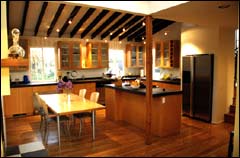The
Basics of Lighting Design
We all want the spaces we inhabit be a reflection of our tastes. When
it comes time to showcase your style, don't forget that it's the lighting
design that makes the difference.
| Quick Navigation: |
How
to: |
 |
 |
A
well-designed lighting plan makes a dramatic statement about house
and owner. |
When it comes to lighting, the biggest challenge is to balance your practical
needs with the vast array of choices for lighting your home and exterior
spaces. Advances in lighting design, techniques and products have made
it possible to create any effect imaginable with the proper type of light,
placement, and fixtures. These three areas form the heart of lighting
design and give homeowners the keys to designing welcoming, functional
spaces that reflect their taste and individuality.
Looking at Lighting Needs
Deciding what to light depends on what you use light for: performing household
tasks, accenting art or architecture, creating a certain mood or ambiance.
Analyze the spaces in your home, because how you use them will drive your
decisions about how to light given areas and what to light them with.
Keep in mind that there are three basic techniques for lighting that are
used by all the pros. Ambient lighting provides general, overall illumination,
promotes safe, easy movement, defines the space, and makes a visual statement
about the comfort of the environment. It can be soft or bright, warm or
cool.
Accent lighting directs additional light and draws attention to selected objects and surfaces. Task lighting illuminates work areas for focused activities such as reading, paper work, food preparation, laundry, games/hobbies, and home office work. At this stage of the planning process, you also want to assign the proper amount of light to an area and decide where to place it in order to avoid glare and unwanted reflections.
Fixtures and Controls
When it comes to selecting fixtures, there is more to it than appearance
and style. Before you invest any money in fixtures, consider the output
you are looking for and how you will control it. Light distribution,
light source, energy efficiency, color appearance and color rendering
are all factors that impact fixture selection. A floodlight, a recessed
can light, and a shaded incandescent table lamp throw totally different
light, so take the time to look at color, output, and distribution.
You may also want to weigh the maintenance and up-front installation
costs of the fixtures you select. Non standard lamps, the design professionals
term for bulbs, can be costly, as can installation and operating costs.
Individual and automatic controls are available and can extend the lamp
life of your fixtures. Controls are also used to highlight tasks, create
a different mood, and give versatility to the overall lighting scheme.